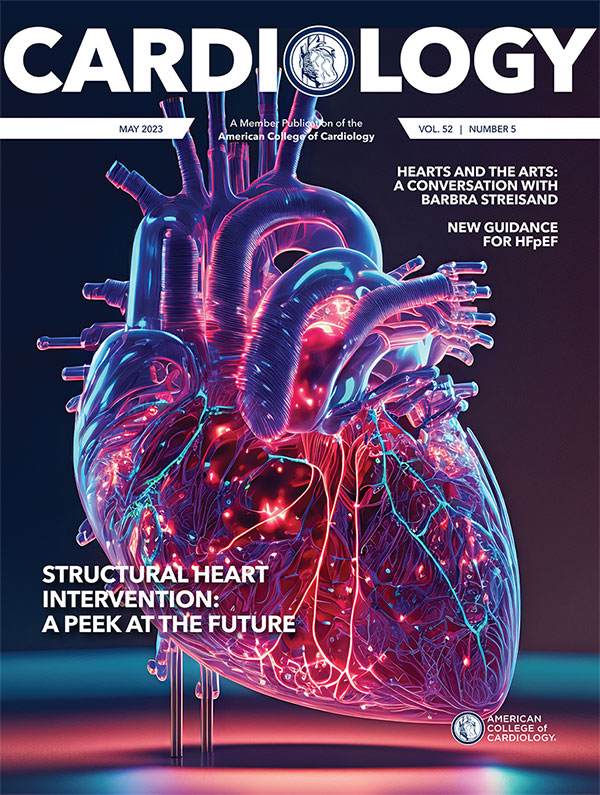Feature | Hearts and the Arts: A Conversation With Barbra Streisand
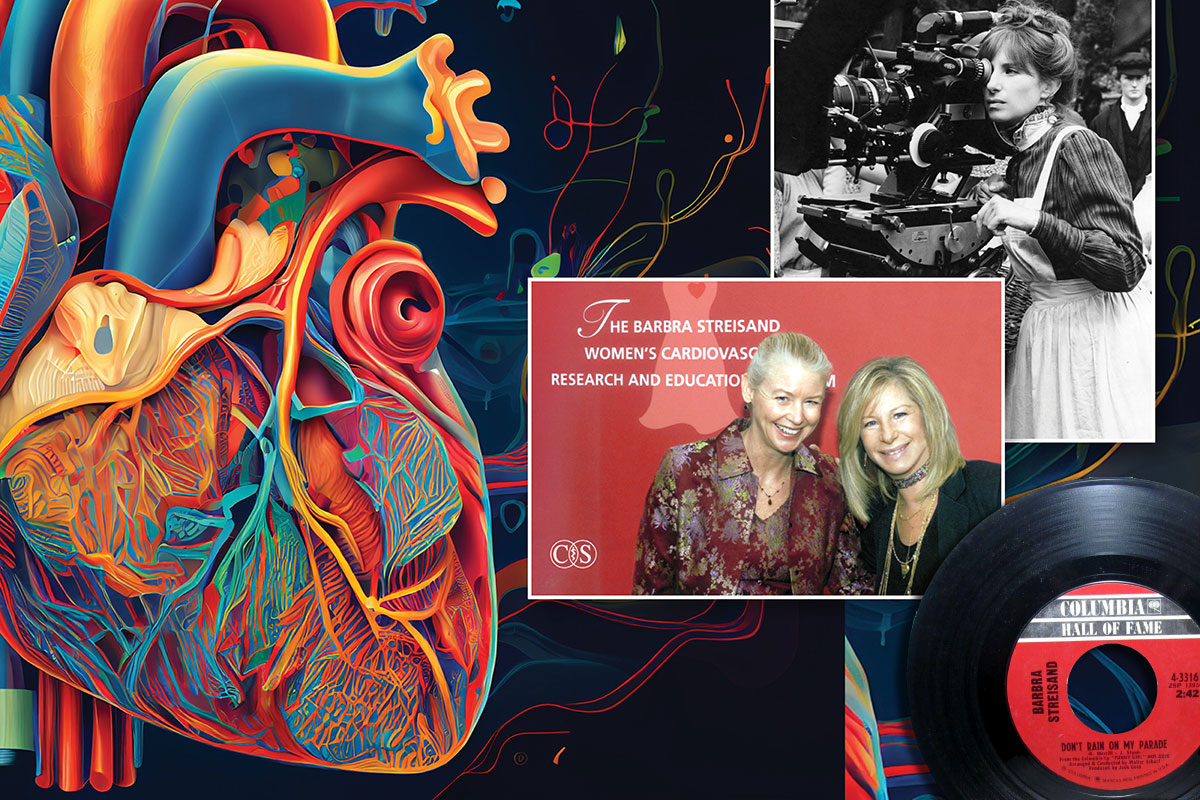
Barbra Streisand's "Don't Rain on My Parade" – the 1968 Funny Girl movie soundtrack version – has been my hype song since high school. I played it to psych myself up as I headed into the MCAT, Step 1, my first day of intern year, and, most recently, every in-service exam and overnight call shift I've had as a cardiology fellow-in-training.
Learning that one of Streisand's foremost philanthropic endeavors is championing the critical cause of improving women's heart health made me feel even more inexplicably linked to her. Here, I pinch myself repeatedly as I fulfill a lifelong personal and professional dream of interviewing Ms. Streisand.
We discussed her work advancing women's cardiovascular health, her career and experience rising through the ranks of a male-dominated field and the role of art in her own life.
Beach: Dr. Bernadine Healy's 1991 editorial in the New England Journal of Medicine titled, "The Yentl Syndrome," highlighted the severe gender biases pervasive in cardiology at that time, both in clinical care and research. In the years since you have donated your time, your name and your wealth to chipping away at these disparities. Have you seen progress made in this area?
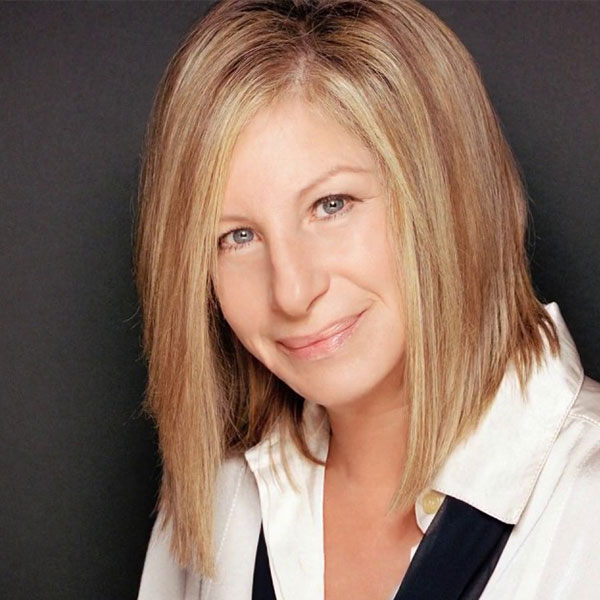
Ten years ago, one in three women were dying of heart disease and now it's one in four. So, yes, there's progress. But not nearly enough.
– Barbra Streisand
Streisand: I am pleased that there has been some progress since I first learned about gender inequality in heart health research, education, diagnosis, treatment and public awareness. Some significant policy changes related to female-pattern heart disease research are now in place. Grants awarded to researchers are coded so that gender issues can be identified. More women are participating in clinical trials. Working with Senators Durbin and McCain, we were able to have the Department of Defense use medical research funds to study the hearts of women in combat. The National Institutes of Health is finally using female mice in their research. I couldn't believe they were only doing research on male mice.
Ten years ago, one in three women were dying of heart disease and now it's one in four.
So, yes, there's progress. But not nearly enough. I'm amazed that Congress finds funds for other medical issues while research on heart disease, the leading killer of women, remains seriously underfunded. It doesn't make sense. It is not right, and I find it unacceptable. Progress is being made but too many women are dying. There is so much more to learn.
Beach: What is your proudest achievement related to your philanthropic work with the Women's Heart Alliance and the Streisand Women's Heart Center at Cedars-Sinai in Los Angeles?
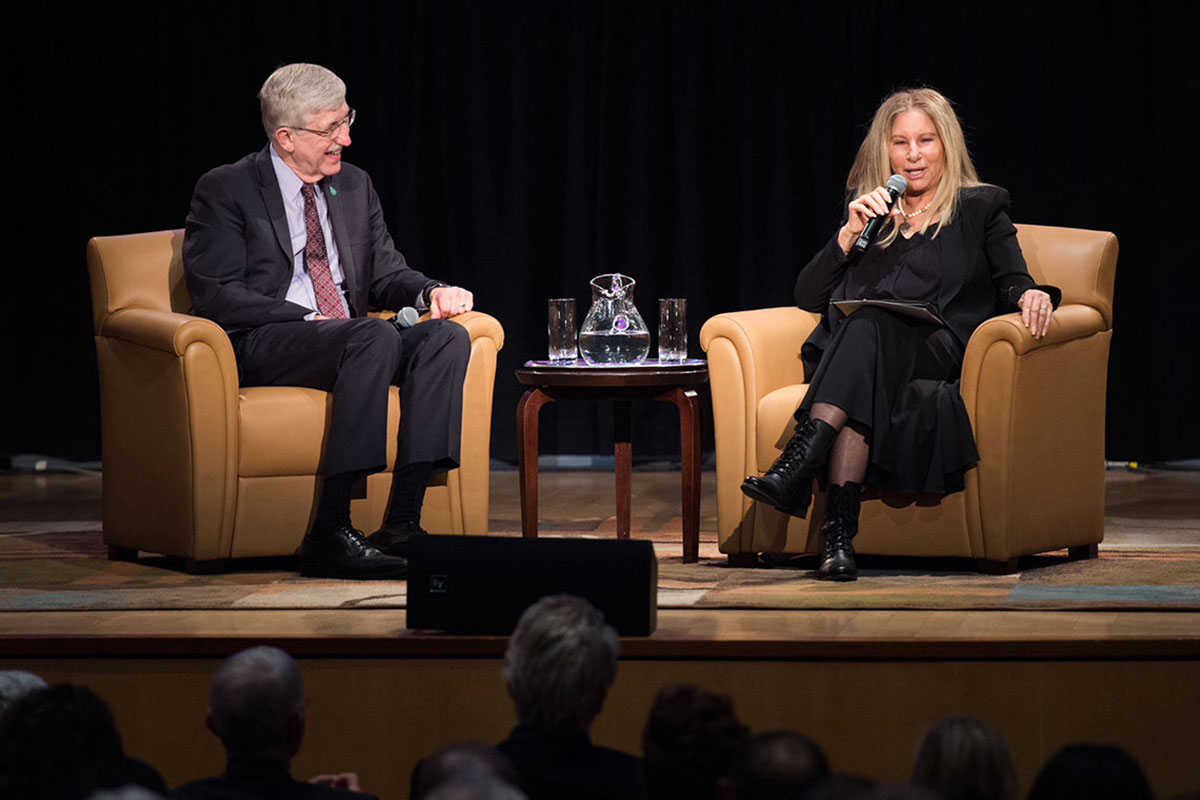 CREDIT: WOMEN'S HEART ALLIANCE
CREDIT: WOMEN'S HEART ALLIANCE
Streisand: My work with the Barbra Streisand Women's Heart Center and the Women's Heart Alliance feeds my desire to keep learning, to make a difference in the world, to help others, to care for the community where I live and most of all to fight for gender equity.
When I commit significant philanthropic support to something, I am absolutely involved in the effort. A passion for equality and a concern for justice has been a constant in my life. I love to keep learning and to understand issues on a deep and meaningful level. I was really stunned to discover how big a problem cardiovascular disease is in women – and that there is so little awareness and understanding of it. This is especially true when it comes to recognizing heart disease in women.
I am so proud of my collaboration with Dr. Noel Bairey Merz. She is a brilliant and renowned scientific researcher and clinician working specifically on female-pattern heart disease. Her study of microvascular heart dysfunction in women is now a recognized research and funding area and has led to greater understanding of gender differences for doctors and scientists.
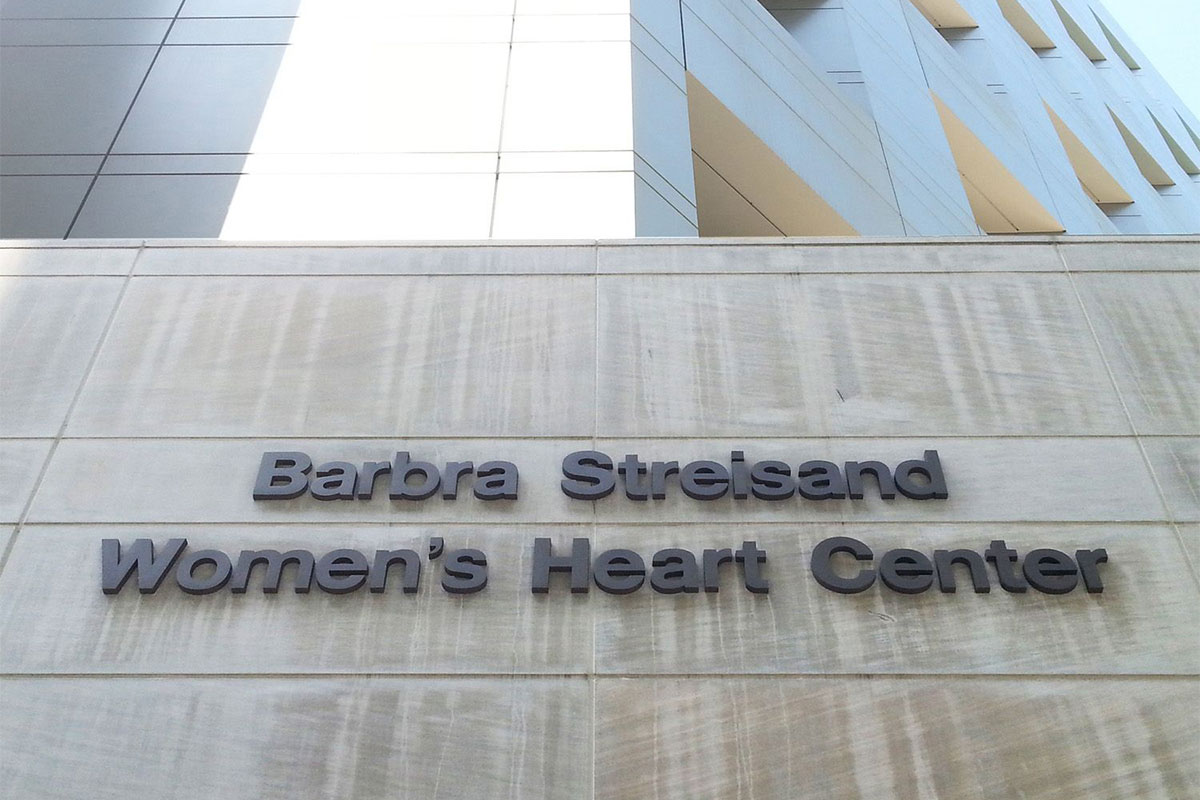 CREDIT: Villa Design Architectural Signage
CREDIT: Villa Design Architectural Signage
The Barbra Streisand Women's Heart Center at Cedars-Sinai Medical Center also focuses on prevention. In addition to doing groundbreaking research, the Center is an exceptional program that provides state-of-the-art diagnostic screening, testing and superb clinical treatment. Patients have complete access to the resources available at this world-class medical center, which by the way is ranked second overall in the U.S.
Also, I am pleased that I can use my personal platform whether it's film, TV, media interviews, appearances, or social media to bring this much-needed awareness to the public. It is immensely gratifying to think that some women's lives are saved because of the support we give to the Center.
Beach: What is the next challenge in women's cardiovascular health that you and your foundation hope to tackle?
Streisand: Our goal is the same as when we began this effort. To realize full gender equality in all phases of cardiovascular disease including research, education, prevention and treatment. We want women to get "heart checked," especially women in underserved communities who are disproportionately affected by heart disease. And we want federal funding for heart health research, education and treatment.
Beach: As a cardiology fellow, I'm training in an environment in which men still far outnumber women. You rose through the ranks of a male-dominated field as a director and producer and ultimately became the first of only three women to date to win a Golden Globe for directing. What career advice do you have for young women physicians in cardiology, or in any profession, who may find themselves outnumbered or outspoken by male colleagues?
Streisand: What first comes to mind is just "keep on trucking." While still a long way to go, finally, women are realizing more of their power.
I have had to confront gender inequality in the workplace from the very start of my career. When I began recording, I faced constant comments from the industry suits about how I needed to change. They suggested I use the stage name Barbra Sands, that I get a nose job, that I dress according to their ideas. I would have none of it. To me, my artistic expression is linked to my authenticity. I was determined to listen to my own instincts and live my inner truth. This decision did have consequences. I was often paid well below the men in my industry. I was stopped from doing some projects because the men thought I should either star or direct and it was too much to want to do both.
When I set out to make the movie Yentl, I confronted the male-dominated movie studios and industry executives who questioned whether a woman could direct a film. It was a tough fight. They placed barriers, hardships, and terms and conditions on me that were never applied to male directors. It took 14 years to make the movie. I was determined that women have the same chances in life as men. It is ironic that the Yentl story line is about a girl who wants to study and learn, which in her time was unavailable to females.
I have experienced serious disappointments. Many of the films I wanted to make never came to fruition. I cared deeply about these projects but for various reasons, some related to my gender, they were not supported.
My advice to young women is stay focused on realizing your goals, keep your determination and spirit. It will require street smarts to figure out how to maneuver to realize your dreams. Be willing to fight for what you think is right, fair and important. Listen to your own thoughts and voice and always speak your truth.
Beach: Just as I'm reaching a point in my medical training when my work and clinical opinions are increasingly respected, our country's politics have been marred by blatant and aggressive efforts to marginalize women and our health. In addition to voting for leaders who will represent and defend our interests, what else should we be doing - and what are you doing - to stay engaged in efforts to codify gender equality and women's rights both in the medical arena and more broadly?
Streisand: Work on these issues at various levels. There are many tools at our disposal. Organize shared goals with others. Make alliances with like-minded people. Use the media to publicize your concerns, support the organizations working on the important issues that matter to you – and yes, participate in the electoral process. We cannot realize the policies we want without supportive people sitting in the seats that determine and legislate the laws. We must elect these leaders and hold them accountable. Just voting is not enough. We need to be activists at all levels of government, federal, state, city and community.
I support numerous organizations and candidates that will stand up for women's voices and fight for equality.
Beach: Though your professional work is already rooted in the arts, have there been creative pursuits outside of work that have been important to your overall wellness?
Streisand: I love art. I love color, design and light. I started collecting paintings when my career first started. Over the years Van Gogh, Edward Hopper and portraits by John Sargent are some of my favorites. My current fascination and interest is with Modigliani. I have visited many of the world's great museums and I marvel over true masterpieces. I always try to pursue excellence in my creative efforts and feel inspired by great artists, whether painters, sculptors, musicians, photographers, writers, actors or directors.
Beach: Are you in the midst of any exciting creative projects right now?
Streisand: I continue to enjoy releasing records but much of my recent attention has been on finishing and editing my own autobiography – a project that has taken many, many years. In writing this book I have been reflecting on my journey through life. While books have been written about me, I felt I wanted to share these moments and times from my own point of view and not from the writings of others who really don't know the truth. Sadly, authors often copy each other and do not bother to fact check for themselves. I like Greek myths but not one's made up and repeated about me.
Beach: Your records have been a central source of resilience and inspiration for me during my medical training. Are there works of art – albums, films, paintings, sculptures, pieces of writing, etc. – that carry great personal significance for you and perhaps have helped you through challenging periods in your life?
Streisand: I'm glad my records have inspired you. I pay a lot of attention to song selection. Songs tell stories, convey feelings and emotions. It is important to me that when they are played, the listener feels their authenticity.
I love watching movies with good character development, interesting stories and wonderful acting. Marlon Brando has always been my favorite actor. Two great directors, whose works I admire and find compelling, are William Wyler and Alejandro Iñárritu.
I have always believed in the power of the truth and that it does transmit to the listener. For me, the music of Maria Callas and Billie Holiday are great expressions of this.
With that, we conclude our interview – and I add some Callas and Holiday standards to my Spotify queue. Despite our very different career paths, Streisand's reflections about inner strength and authenticity in the face of professional challenges resonate with me. Though I'll never match the power and precision of her high belt, I will certainly heed her advice to "keep on trucking" in my cardiology training and our shared efforts to improve women's cardiovascular health outcomes.
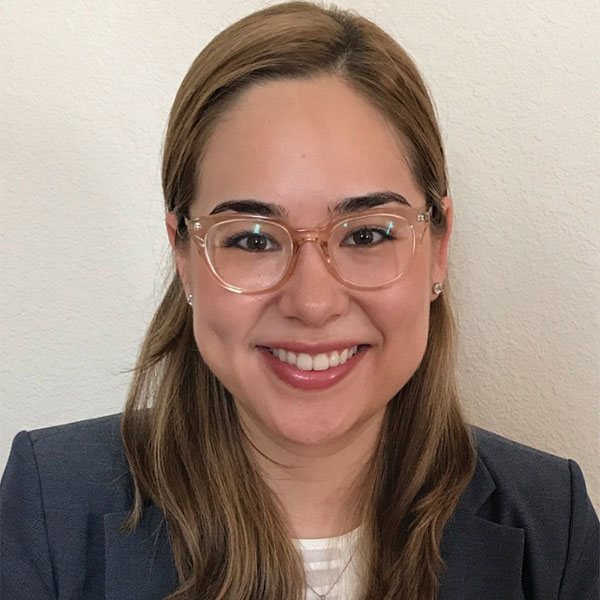
This interview was authored by Shire Lynn Beach, MD, a fellow in training at Stanford University Medical Center in Palo Alto, CA.
Clinical Topics: Acute Coronary Syndromes, Anticoagulation Management, Arrhythmias and Clinical EP, Cardiac Surgery, Congenital Heart Disease and Pediatric Cardiology, Diabetes and Cardiometabolic Disease, Dyslipidemia, Geriatric Cardiology, Heart Failure and Cardiomyopathies, Invasive Cardiovascular Angiography and Intervention, Noninvasive Imaging, Pericardial Disease, Prevention, Pulmonary Hypertension and Venous Thromboembolism, Sports and Exercise Cardiology, Stable Ischemic Heart Disease, Valvular Heart Disease, Vascular Medicine, Anticoagulation Management and ACS, Implantable Devices, SCD/Ventricular Arrhythmias, Atrial Fibrillation/Supraventricular Arrhythmias, Cardiac Surgery and Arrhythmias, Cardiac Surgery and CHD and Pediatrics, Cardiac Surgery and Heart Failure, Cardiac Surgery and SIHD, Cardiac Surgery and VHD, Congenital Heart Disease, CHD and Pediatrics and Arrhythmias, CHD and Pediatrics and Imaging, CHD and Pediatrics and Interventions, CHD and Pediatrics and Prevention, Acute Heart Failure, Pulmonary Hypertension, Interventions and ACS, Interventions and Imaging, Interventions and Structural Heart Disease, Interventions and Vascular Medicine, Angiography, Nuclear Imaging, Hypertension, Sleep Apnea, Sports and Exercise and Congenital Heart Disease and Pediatric Cardiology, Sports and Exercise and ECG and Stress Testing, Sports and Exercise and Imaging, Chronic Angina
Keywords: ACC Publications, Cardiology Magazine, Acute Coronary Syndrome, Anticoagulants, Arrhythmias, Cardiac, Cardiac Surgical Procedures, Metabolic Syndrome, Angina, Stable, Heart Defects, Congenital, Dyslipidemias, Geriatrics, Heart Failure, Angiography, Diagnostic Imaging, Pericarditis, Secondary Prevention, Hypertension, Pulmonary, Sleep Apnea Syndromes, Sports, Exercise Test, Heart Valve Diseases, Aneurysm
< Back to Listings

